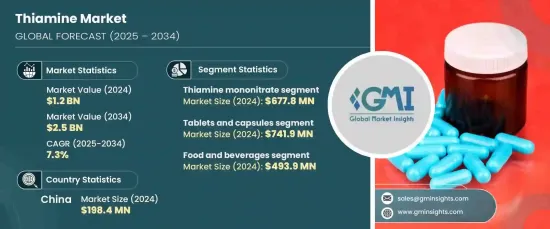
세계의 티아민 시장은 2024년에 12억 달러에 달하며, 2025-2034년에 7.3%의 CAGR로 성장할 것으로 예측됩니다.
비타민 B1으로도 알려진 티아민은 에너지 대사, 신경 기능, DNA와 RNA 합성을 보조하여 인간의 건강을 유지하는 데 중요한 역할을 합니다. 균형 잡힌 식습관을 유지하는 데 있으며, 티아민 보충제 및 강화 식품에 대한 수요가 증가함에 따라 티아민 보충제 및 강화 식품에 대한 수요가 급증하고 있습니다. 이러한 수요 증가는 건강과 영양 부족에 대한 소비자의 인식이 높아지면서 더욱 가속화되고 있습니다.

티아민의 다용도성은 의약품, 식품 및 음료, 사료 등 다양한 산업에서 사용되는 것을 보면 알 수 있습니다. 의약품에서 티아민은 신경 및 심혈관 질환 등 티아민 결핍으로 인한 증상을 치료하는 데 널리 사용됩니다. 또한 종합비타민의 주요 성분으로 광범위한 영양 결핍을 해소하는 데 도움이 됩니다. 식품 분야에서 티아민은 시리얼, 빵, 보충제 등 주식에 자주 첨가되어 영양가를 높이고 있습니다. 영양 강화 식품에 대한 선호도가 높아짐에 따라 기술 혁신이 촉진되어 제조업체가 다양한 제품에 티아민을 통합할 수 있게 되어 시장 수요가 증가하고 있습니다.
| 시장 범위 | |
|---|---|
| 시작연도 | 2024년 |
| 예측연도 | 2025-2034년 |
| 시작 금액 | 12억 달러 |
| 예상 금액 | 25억 달러 |
| CAGR | 7.3% |
다양한 형태의 티아민 중에서도 티아민 일질산염은 안정성과 범용성으로 인해 큰 시장 점유율을 차지하고 있습니다. 보다 안정적인 유도체로서 열과 빛과 같은 환경적 요인에 잘 견디기 때문에 식품 강화 및 의약품에 사용하기에 이상적입니다. 티아민은 일반적으로 강화 시리얼, 빵, 보충제에 함유되어 필요한 영양소를 확실히 공급합니다. 제약 산업에서 티아민 일질산염은 종합비타민제와 주사제에 자주 사용됩니다. 또한 가축 사료의 중요한 성분으로 가축의 건강과 생산성을 지원하는 중요한 성분이기도 합니다.
정제 및 캡슐 부문이 티아민 시장을 주도하고 있으며, 정확한 투여, 편의성 및 광범위한 가용성으로 인해 큰 매출을 창출하고 있습니다. 정제는 비용 효율적이고 대량 생산이 용이하여 선호되고 있으며, 전 세계 헬스케어 시장과 소매 시장에서 필수품으로 자리 잡았습니다. 반면, 캡슐은 빠른 흡수 속도와 적은 위장 장애를 원하는 사람들에게 어필하고 있습니다. 두 형태 모두 휴대가 간편하고 유통기한이 길어 그 인기가 더욱 높아지고 있습니다.
식품 및 음료 분야에서 티아민은 영양 강화 제품 및 건강 보조 식품에 큰 기여를 하고 있으며, 이 분야는 안정적인 성장이 예상됩니다. 시리얼, 빵, 에너지 음료 등 식품에 자주 첨가되어 영양 부족을 해결하고 있습니다. 건강한 식품 옵션과 기능성 식품 및 음료에 대한 소비자 수요 증가와 영양 강화에 대한 규제 요건이 결합되어 이 시장 부문의 지속적인 성장을 보장하고 있습니다.
중국은 풍부한 원료, 비용 효율적인 제조, 탄탄한 생산 인프라를 바탕으로 티아민 시장에서 확고한 입지를 유지할 것으로 예상됩니다. 수출 확대와 R&D 투자에 중점을 둔 중국은 세계 티아민 시장의 주요 기업으로 남아 안정적인 공급을 보장하고 티아민 생산의 혁신을 촉진하고 있습니다.
The Global Thiamine Market, valued at USD 1.2 billion in 2024, is projected to grow at a CAGR of 7.3% from 2025 to 2034. Thiamine, also known as Vitamin B1, plays a vital role in supporting human health by assisting in energy metabolism, nerve function, and DNA and RNA synthesis. Its growing importance in maintaining a balanced diet has led to increased demand for thiamine supplements and fortified food products. This surge is further amplified by rising consumer awareness of health and nutritional deficiencies.

The versatility of thiamine is evident in its applications across multiple industries, such as pharmaceuticals, food and beverages, and animal feed. In pharmaceuticals, thiamine is widely used to treat conditions resulting from its deficiency, such as nerve and cardiovascular issues. It is also a key ingredient in multivitamins, helping to address a broad spectrum of nutritional gaps. In the food sector, thiamine is frequently added to staple items like cereals, bread, and supplements, enhancing their nutritional value. The growing preference for fortified foods is driving innovation, allowing manufacturers to incorporate thiamine into a wide variety of products, boosting market demand.
| Market Scope | |
|---|---|
| Start Year | 2024 |
| Forecast Year | 2025-2034 |
| Start Value | $1.2 Billion |
| Forecast Value | $2.5 Billion |
| CAGR | 7.3% |
Among the various forms of thiamine, thiamine mononitrate holds a significant market share due to its stability and versatility. As a more stable derivative, it withstands environmental factors like heat and light, making it ideal for use in food fortification and pharmaceuticals. It is commonly found in fortified cereals, bread, and supplements, ensuring essential nutrient delivery. In the pharmaceutical industry, thiamine mononitrate is commonly used in multivitamin tablets and injectable formulations. It is also an important ingredient in animal feed, supporting livestock health and productivity.
The tablets and capsules segment leads the thiamine market, generating significant revenue due to their precise dosing, convenience, and widespread availability. Tablets are favored for their cost-effectiveness and ease of mass production, making them a staple in healthcare and retail markets worldwide. On the other hand, capsules appeal to those looking for faster absorption and less gastrointestinal discomfort. Both formats are highly portable and have a long shelf life, further boosting their popularity.
In the food and beverage sector, thiamine's contribution to fortified products and nutritional supplements is substantial, and the segment is expected to grow steadily. It is frequently added to foods like cereals, bread, and energy drinks, addressing nutritional deficiencies. The increasing consumer demand for healthier food options and functional beverages, combined with regulatory requirements for fortification, ensures the continued growth of this market segment.
China is expected to maintain a strong position in the thiamine market, benefiting from abundant raw materials, cost-effective manufacturing, and a solid production infrastructure. With a strong focus on expanding exports and investing in research and development, China remains a major player in the global thiamine market, ensuring a steady supply and fostering innovations in thiamine production.